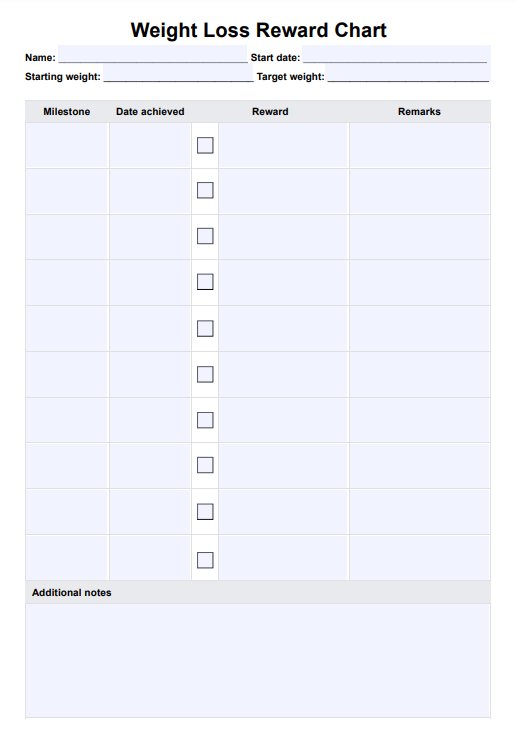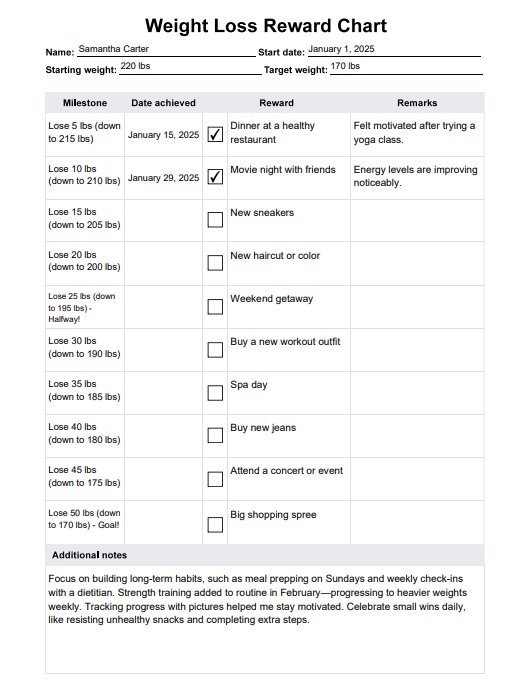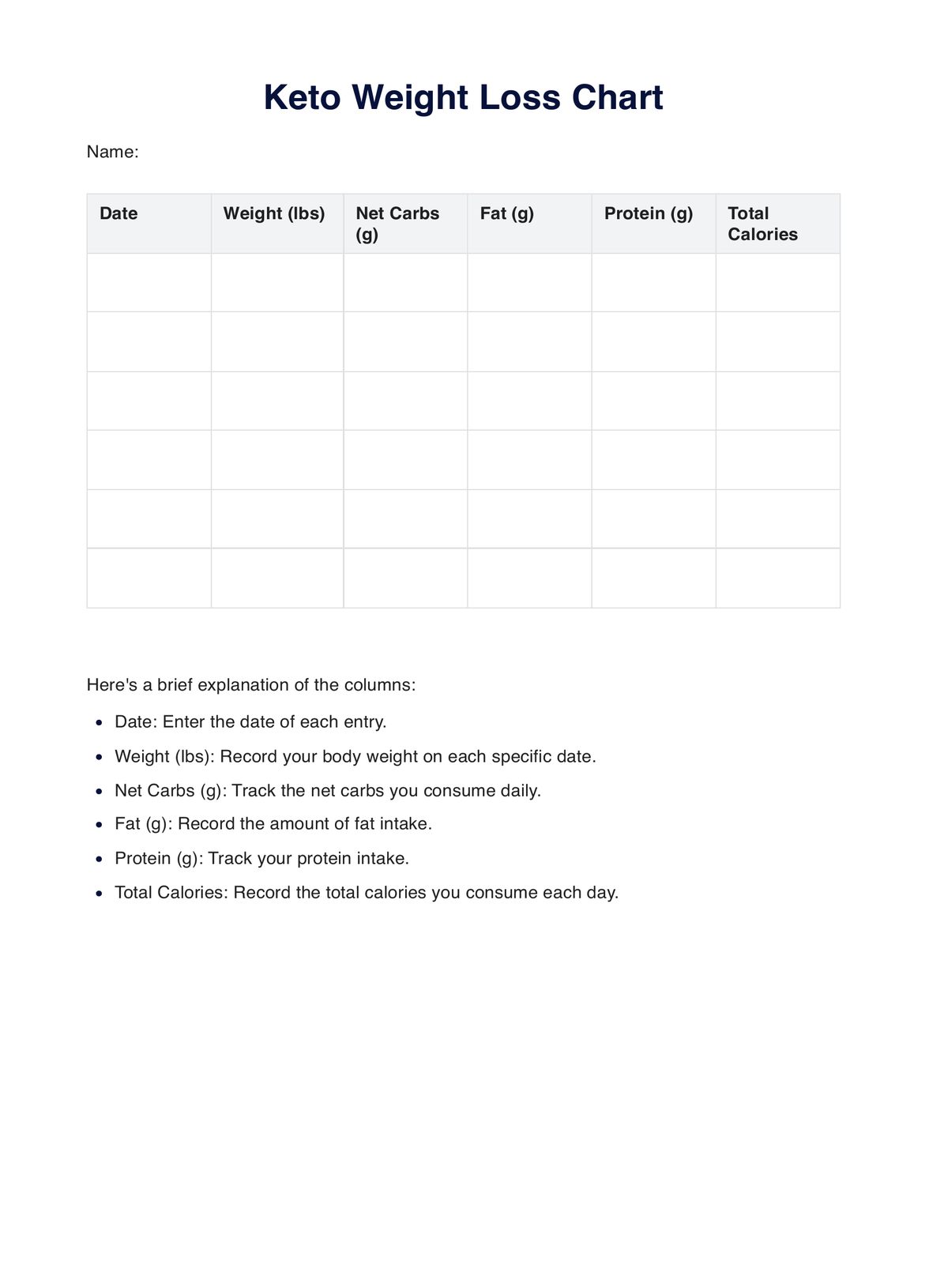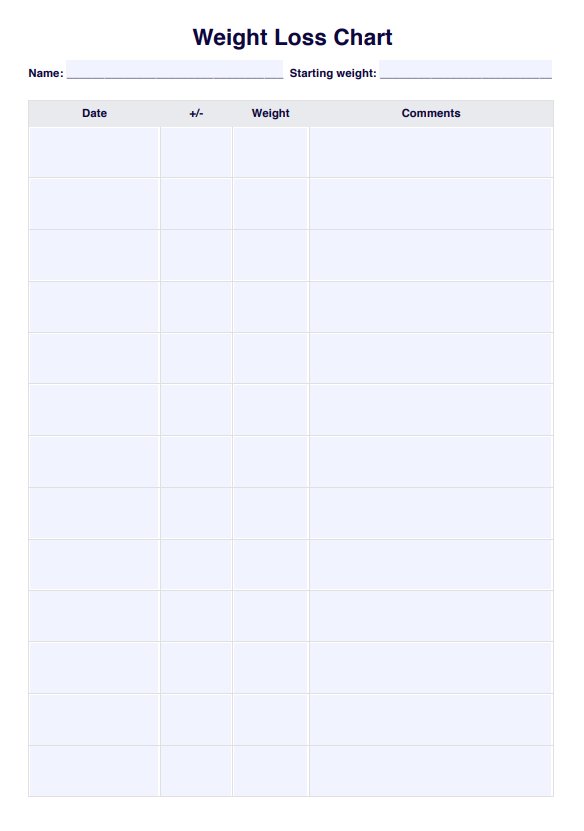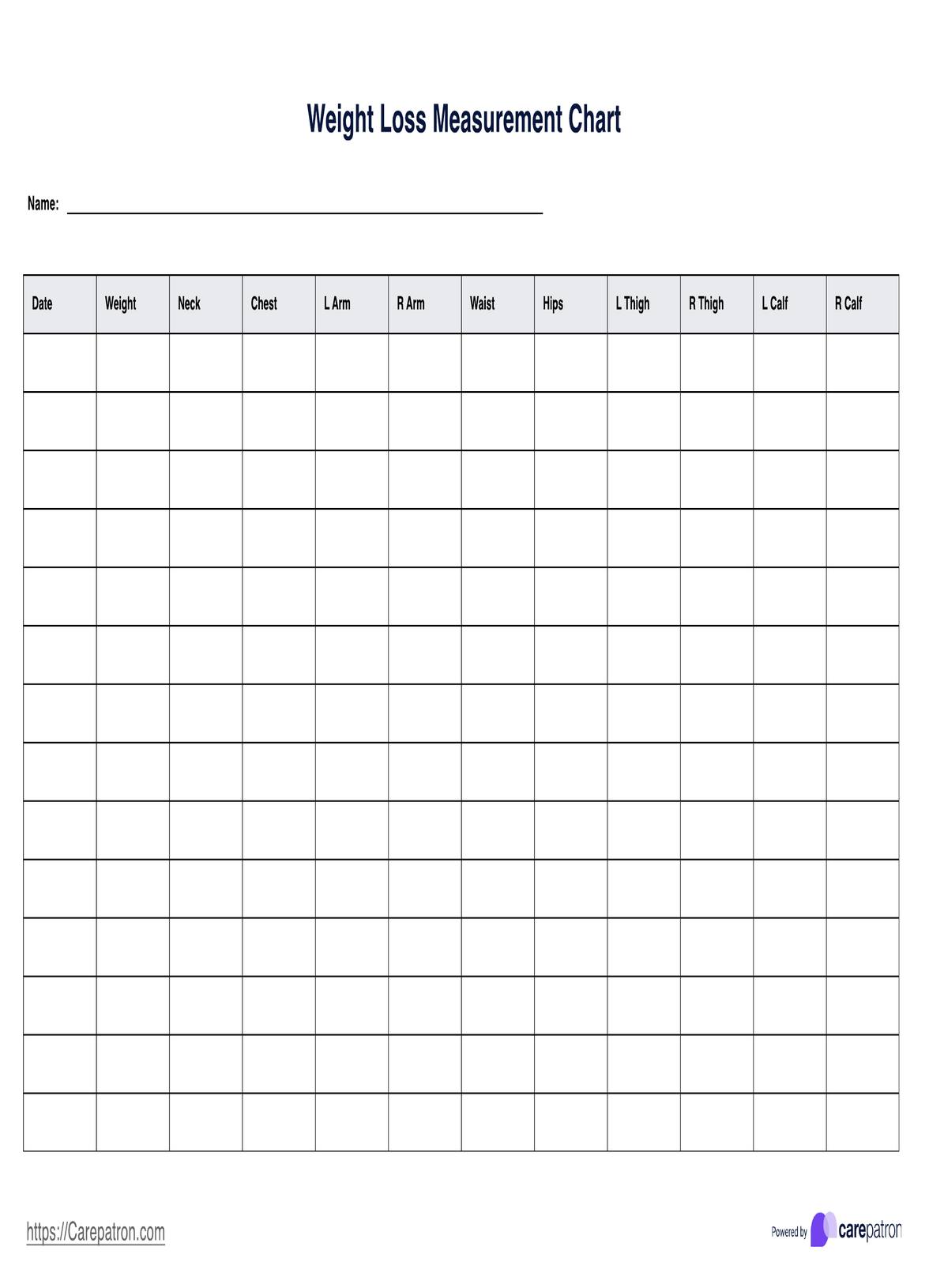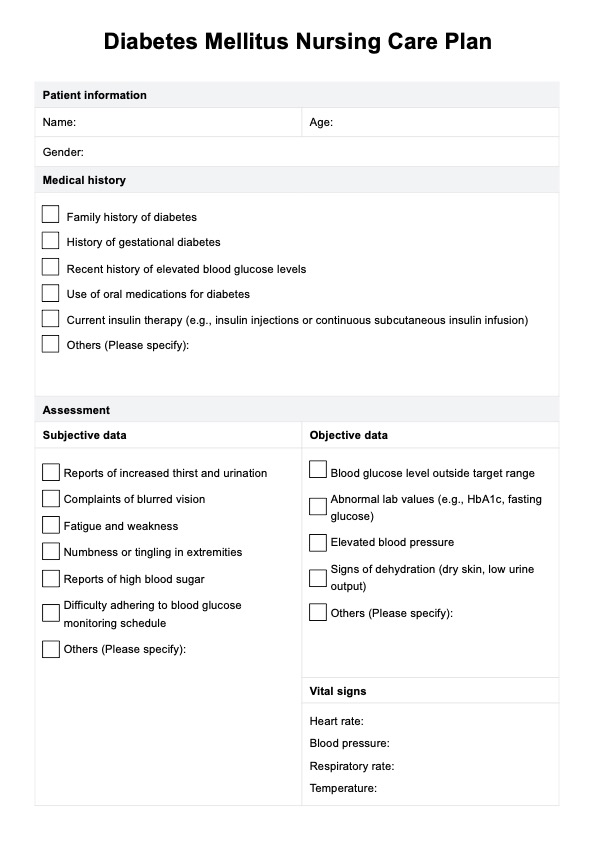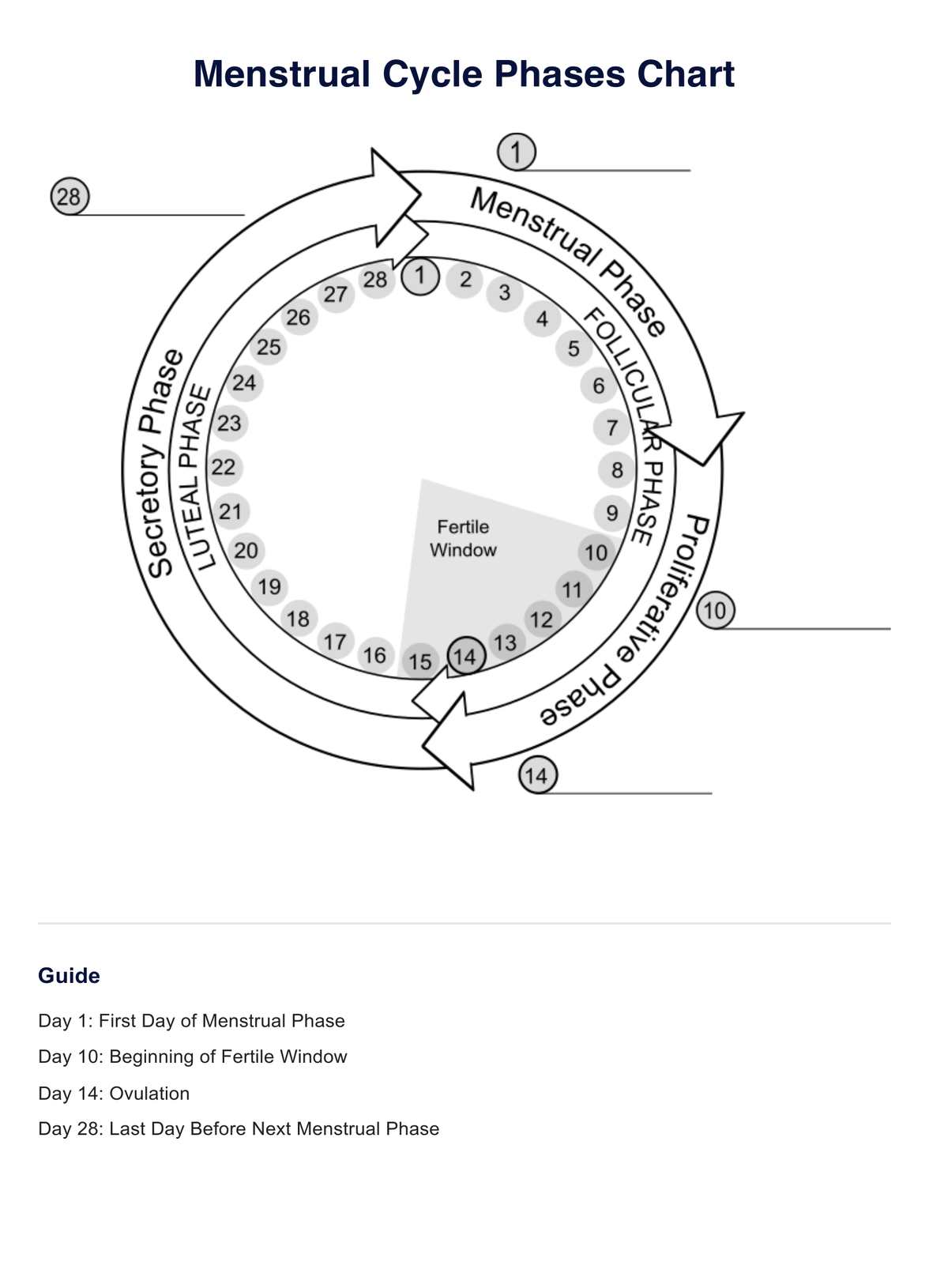Weight Loss Reward Chart
Teach clients how to leverage non-food-related rewards to encourage weight loss, with our Weight Loss Reward Chart Template. Try it now!


What is a weight loss reward chart?
A weight loss reward chart is a motivational tool designed to help individuals track progress and celebrate milestones during their weight loss journey. By visually breaking down a big goal into smaller, achievable targets, the chart keeps individuals focused and motivated to lose weight while reinforcing positive habits. The chart incorporates unique weight loss rewards to celebrate progress, promoting a sense of achievement and encouraging continued effort.
This chart provides a structured framework for healthcare and fitness professionals, such as dietitians, personal trainers, and weight loss coaches, to support clients in achieving their goals. It emphasizes planning rewards that align with the client's preferences and non-food-related incentives to maintain a healthy mindset. Professionals can customize the chart to suit each client’s big goal, whether related to weight, body measurements, or fitness achievements.
This chart works by transforming the long-term weight loss journey into a series of manageable and rewarding steps, fostering success through sustained engagement and celebrating every milestone reached. This approach helps clients maintain a positive outlook, keeping them motivated and focused on their ultimate weight loss goals.
Weight Loss Reward Chart Template
Weight Loss Reward Chart Example
How to use our Weight Loss Reward Chart Template?
Our Printable Weight Loss Reward Chart Template provides healthcare and fitness professionals with an easy-to-use tool to support their clients in reaching their goals. The template includes customizable fields to document milestones, rewards, and progress. Follow these steps to maximize its utility:
Step 1: Access the template
Click the "Use template" button on this page to open the editable chart in our platform or choose the "Download" button to save a printable PDF version. Ensure you have a copy ready for client consultations or personal use.
Step 2: Guide your client in setting milestones
Work with your client to decide on achievable milestones that align with their ultimate weight loss or fitness big goal. These can be weight-based (e.g., every 5 lbs lost), measurement-based (e.g., inches off the waist), or performance-based (e.g., completing a specific exercise). Collaborate to make these milestones realistic and meaningful.
Step 3: Plan unique, non-food-related rewards
Help your client brainstorm unique weight loss rewards that suit their preferences. For example, suggest a movie night, new workout gear, or a relaxing massage. Avoid food-related rewards to encourage healthy habits. Document these rewards alongside the milestones on the chart.
Step 4: Encourage ongoing use and celebrate progress
Teach your client how to fill in the chart as they achieve each milestone. Encourage them to note the date they reach a goal and check off their reward. Review their progress during follow-ups to celebrate successes and adjust goals or rewards as needed.
When would you use this template?
The Weight Loss Reward Chart Template can be a valuable tool in various scenarios to help healthcare and fitness professionals motivate clients and support their weight loss journey. Here are some instances where this template is particularly beneficial:
- Bariatric surgery preparation and recovery: Use the chart to encourage adherence to pre-surgery weight loss requirements and celebrate post-surgery progress. It keeps patients motivated during their transformative journey.
- Type II diabetes management: For clients aiming to improve blood sugar control or reverse symptoms through weight loss, the chart reinforces positive behaviors and tracks measurable outcomes.
- Long-term weight loss programs: Ideal for clients with significant goals, this chart helps break down larger targets into manageable milestones, keeping motivation high over extended periods.
- General weight management: Support clients who are overweight or obese with a structured tool that reinforces lifestyle changes and celebrates non-scale victories.
- Fitness improvement goals: Clients focused on physical fitness improvements, like increasing stamina or strength, can benefit from this chart to track and reward progress beyond losing weight alone.
Benefits of this Weight Loss Reward Chart Template
This Weight Loss Reward Chart Template is designed to provide healthcare and fitness professionals with a structured and motivational tool for their clients. Here are its key benefits:
- Tracks progress effectively: The template allows professionals and clients to monitor weight loss milestones, offering a tangible record of achievements that reinforces motivation and highlights success over time.
- Encourages goal setting: By breaking down larger goals into smaller, manageable milestones, the chart helps clients focus on incremental progress, making the weight loss journey less overwhelming.
- Promotes non-food rewards: The template emphasizes unique weight loss rewards unrelated to food, encouraging clients to celebrate their successes in healthy and constructive ways.
- Supports personalized care: With customizable fields, professionals can tailor the chart to each client’s preferences, lifestyle, and goals, creating a resource that aligns with individual needs.
- Boosts client engagement: By including motivational rewards and measurable outcomes, the chart fosters a sense of accomplishment and keeps clients committed to their weight loss plan.
- Enhances professional-client collaboration: Professionals can use the chart as a communication tool to discuss progress, identify challenges, and adjust strategies for better results.
Commonly asked questions
Yes, rewards can be highly effective for weight loss as they reinforce positive behaviors and provide motivation. Research suggests that non-food-related rewards linked to achieving a specific milestone or weight loss goal can help sustain long-term engagement and adherence to a weight loss plan.
The 50% rule for weight loss refers to focusing on smaller goals incrementally by achieving 50% of your long-term goal initially. This strategy helps maintain motivation by creating manageable short-term successes, which build confidence and consistency.
Rewards should align with your client's interests and preferences to keep them motivated. Examples include cinema tickets, spa treatments, new clothing, fitness equipment, or experiences such as a weekend getaway or photoshoot. Non-food-related rewards are especially encouraged for healthy habit formation.
Healthcare professionals should encourage rewards tied to achievable short-term goals, such as losing 5–10 pounds or reaching a fitness milestone. This frequency maintains consistent motivation without overwhelming clients or delaying gratification for too long.


